Uranium Ore Deposits
Uranium Ore Deposits
Uranium Ore Deposits
Create successful ePaper yourself
Turn your PDF publications into a flip-book with our unique Google optimized e-Paper software.
EDUCATION<br />
Fig. 3: <strong>Uranium</strong> mine production and civilian demand since 1945. Note<br />
the difference between demand and mine production since the 1990s<br />
which is mainly covered by recycled uranium from military inventories.<br />
(Source: Nuclear Energy Agency 2008).<br />
<strong>Uranium</strong> was discovered in pitchblende ore from Johanngeorgenstadt<br />
in the Erzgebirge by the Berlin pharmacist<br />
Klaproth in 1789, and only gained wider interest 150<br />
years later, when Hahn and Strassmann, again in Berlin,<br />
discovered nuclear fission of 235 U in 1938. This process liberates<br />
more neutrons than it consumes which allows a<br />
chain reaction provided a critical mass of several kg 235 U<br />
is assembled. It then took only four years to construct the<br />
first nuclear reactor in Chicago, and another three years<br />
to test the first atomic bomb in Nevada, and to destroy<br />
the cities of Hiroshima and Nagasaki with a uranium<br />
(60 kg 235 U) and a plutonium (8 kg 239 Pu) bomb, respectively.<br />
This development started a frantic and very costly arms<br />
race of about 30 years in which several countries tested<br />
and developed a wide range of nuclear technology and<br />
stockpiled thousands of nuclear warheads, part of which<br />
are now reconverted for fuel in power plants. Ironically,<br />
half of the US commercial reactor fuel today is from Russian<br />
nuclear warheads.<br />
Geochemical background<br />
The upper 10 km of the Earth‘s continental crust have an<br />
average abundance of 2.7 g/t U (Rudnick & Gao 2003). The<br />
grade of uranium ore deposits ranges from a few hundred<br />
g/t U to more than 20 % U. Therefore, an ore-forming<br />
process is required which enriches uranium over its global<br />
geochemical background by a factor of 100 to 10,000.<br />
Such enrichment is possible by leaching of large rock volumes<br />
by oxidized warm water and precipitation of uranium<br />
(commonly in the form of uraninite, UO 2<br />
, also known as<br />
pitchblende, due to its black color) in such places where<br />
the solubility of uranium changes. <strong>Uranium</strong> exists in two<br />
oxidation states. <strong>Uranium</strong> in the 6 + state is highly soluble,<br />
while uranium in the 4 + state is highly insoluble. This can be<br />
condensed into the general geochemical formulation:<br />
U 6+ (aqueous) + 2 e - = U 4+ ↓ (precipitation)<br />
Or, in a natural system,<br />
UO 2<br />
(CO 3<br />
) 2<br />
2-<br />
+ 2 H + = UO 2<br />
+ ½ O 2<br />
+ 2 CO 2<br />
+ H 2<br />
O (1)<br />
Note that there are many other possible uranium complexes<br />
in nature, but the underlying theme is the dissolved<br />
U species in the 6 + state, while the precipitated U species<br />
is in the 4 + state. The solubility of U 4+ at low temperatures is<br />
extremely low, similar to thorium as Th 4+ .<br />
However, thorium, as opposed to uranium, has no oxidized<br />
species which is why it is not enriched in low-temperature<br />
hydrothermal deposits. Only under high-temperature<br />
conditions, particularly in silicate melts, uranium and<br />
thorium can become enriched synchroneously due to their<br />
common large ionic radius and high charge and then can<br />
form U-Th deposits in pegmatites and alkaline granites.<br />
Equation (1) describes sufficiently both the formation of<br />
hydrothermal uranium ore deposits (reaction from the left<br />
to the right side), as well as their mining by in-situ solution<br />
techniques (reaction from right to left).<br />
The solubility of uranium as described in (1) can then be<br />
formulated as<br />
2-<br />
log K = log [UO 2<br />
(CO 3<br />
) 2<br />
] + 2 log [H + ] - ½ log [O 2<br />
] - 2 log [CO 2<br />
]<br />
2-<br />
log [UO 2<br />
(CO 3<br />
) 2<br />
] = log K + 2 pH + ½ log [O 2<br />
] + 2 log [CO 2<br />
]<br />
This equation describes the solubility of uranium as a function<br />
of pH, oxidation state, and CO 2<br />
fugacity. Given a situation<br />
where pH is buffered by rocks, the solubility of uranium<br />
will be controlled by the concentration of CO 2<br />
and O 2<br />
in the<br />
solution. A practical example for this relationship is given in<br />
Figure 4, where the change from an oxidized environment<br />
with U soluble to a reduced environment with U insoluble<br />
can be read directly from the rock. <strong>Uranium</strong> ore formation<br />
by precipitation as uraninite from oxidized solutions marks<br />
the transition from oxidized to reduced environments.<br />
Issue 02 | 2008<br />
www.advanced-mining.com<br />
18










